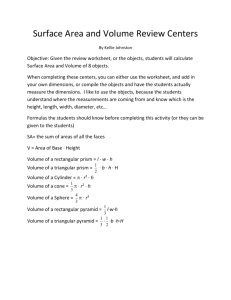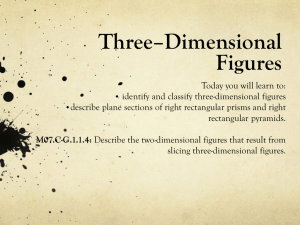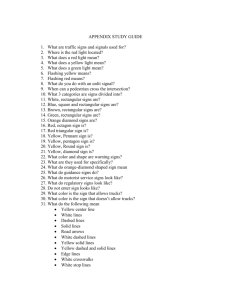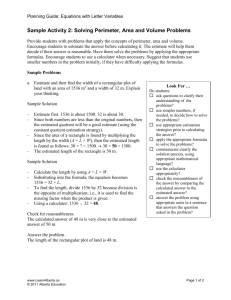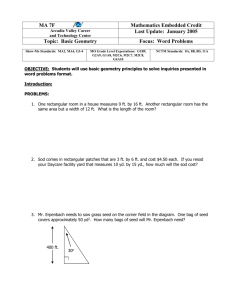Pythagorean Theorem and 3-D Figures
advertisement
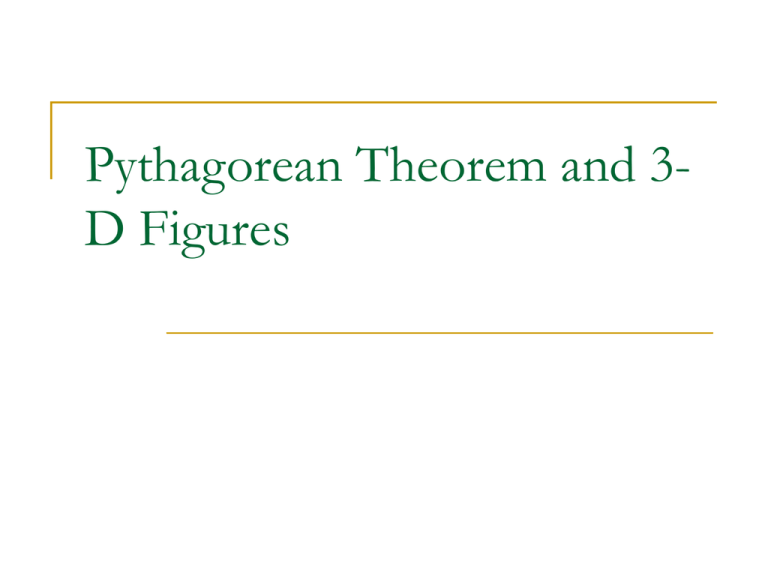
Pythagorean Theorem and 3D Figures Rectangular solids Every rectangular solid has: 6 rectangular faces: 1. re c ta n g le A B H G 2. re cta n g le B D F H 3. re c ta n g le D C E F 4. re c ta n g le C A G E 5. re c ta n g le C D B A 6. re cta n g le E F H G 12 edges: 1. A C 3. D B 5. A G 7. H F 9. E G 11. D F 2. 4. 6. 8. 10. 12. CD BA GH FE BH CE 4 diagonals: 1. A F 2. C H 3. D G 4. BE A cube is a rectangular solid in which all edges are congruent. All faces are squares! Regular Square Pyramid KLQP is a square and is called the base. J is the vertex. J M is the altitude of the pyramid and is perpendicular to the base at its center. J N is called the slant height and is perpendicular to a side of the base. Example 1: This box is a rectangular solid. If BC = 3, what is AD? A D 3 If AB = 4 what is DB? Must use BC = 3 to find 2 2 3 4 DB 2 DB 5 If CG =12, what is DH? D H 12 What is BH? AG? Use DB = 5 2 2 2 5 12 BH B H 13 A G 13 Example 2: The dimensions of a rectangular solid are 3, 5, and 7. Find the diagonal. Draw a rectangular solid. Does it matter where the numbers go? 1st possibility Find AH To find AH first must find DH 2 3 7 2 DH DH 2 58 Use DH to find AH 58 2 AH 2 5 AH 83 2 Example 2: 2nd possibility Find AH To find AH first must find DH 2 2 3 5 DH DH 2 34 Use DH to find AH 34 AH 2 7 2 83 AH 2 Example 2: 3rd possibility Find AH To find AH first must find DH 2 2 7 5 DH DH 2 74 Use DH to find AH 74 AH 2 2 3 AH 83 2 Example 3: PR The square pyramid has altitude , slant PS height , perimeter of JKMO = 40, and PK = 13. Find a.) JK Since it is a square pyramid, the base is a square A square has 4 congruent sides If the perimeter is 40 then each side is 10 so JK = 10 b.) PS In a square pyramid, the slant height bisects the base edge So KS = 5 Use PK = 13 to find PS 2 2 13 5 PS PS = 12 2 C.) PR In a square pyramid, the altitude height bisects the base edge So RS = 5 Use PS = 12 to find PR 2 2 12 5 PR PR 119 2 In review, With any type of solid, you need to create right triangles that you can use the Pythagorean to find the missing length. You may need to use the Pythagorean theorem more than once to find the missing length.
